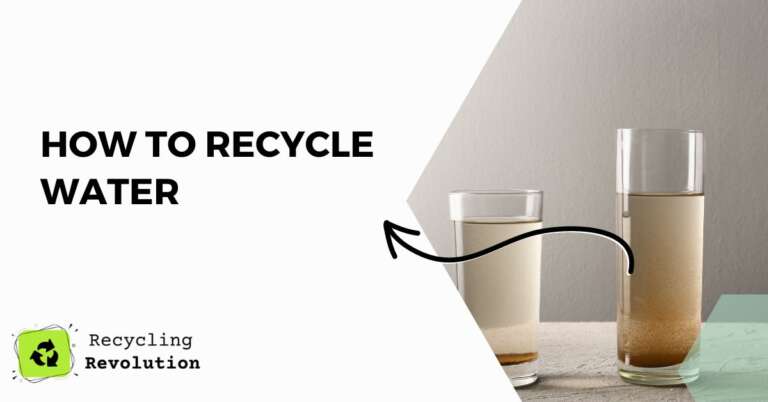Close your eyes and picture a world without water. It’s a grim thought, isn’t it? Our very existence hinges on this precious resource, and yet water scarcity is becoming an increasingly pressing issue.
As the world’s population grows and climate change intensifies, water conservation has become an essential practice to preserve the environment and ensure the well-being of our planet.
Enter water recycling, a brilliant solution that helps mitigate water scarcity and contributes to the sustainable use of resources. This guide will walk you through the intricacies of water recycling, how it works, and how you can benefit from it.
Understanding Water Recycling
Water recycling, also known as water reclamation, is the process of treating and reusing wastewater for various purposes, such as irrigation, industrial processes, and even drinking water. This essential practice not only conserves water but also reduces the pressure on our already strained freshwater sources.
The Two Faces of Wastewater: Greywater and Blackwater
Before diving into water recycling techniques, it’s crucial to distinguish between greywater and blackwater. Greywater is relatively clean wastewater generated from activities like bathing, laundry, and dishwashing, while blackwater contains human waste, usually from toilets. The treatment methods for each type of water differ, as do their potential uses after treatment.
Water Recycling Techniques
From Waste to Reuse
Water recycling techniques can be broadly categorized into three stages: primary, secondary, and tertiary treatment.
Primary treatment involves removing large particles, secondary treatment focuses on breaking down organic matter, and tertiary treatment purifies the water further to meet specific requirements.
Maintaining the Fountain of Reclaimed Water
Water recycling systems, whether large-scale or small-scale, require regular maintenance to ensure efficiency and safety. This includes periodic cleaning, monitoring, and replacing filters and membranes as needed.
With proper care, these systems can provide a reliable source of recycled water for years to come.
Water Recycling in Different Settings
Home is Where the Water Flows
Residential water recycling can take various forms, from simple greywater diversion systems for garden irrigation to more sophisticated systems that treat blackwater for non-potable uses.
By implementing water recycling at home, you’ll not only save money on your water bill but also contribute to a more sustainable future.
Commercial Buildings
Water recycling in commercial settings, such as office buildings and hotels, can significantly reduce water consumption and lower operational costs. Installing greywater recycling systems for landscaping and toilet flushing or using treated blackwater for cooling towers can make a big difference.
Fields of Green: Water Recycling in the Agriculture Industry
Agriculture and industry are major water consumers, which makes them ideal candidates for water recycling. From using treated wastewater for crop irrigation to incorporating recycled water in industrial processes, these sectors can play a pivotal role in global water conservation efforts.
Benefits of Water Recycling
A Greener Planet: The Environmental Perks of Water Recycling
Water recycling benefits the environment in multiple ways, such as reducing the demand for freshwater, decreasing the discharge of pollutants, and mitigating the impacts of droughts and climate change.
Economic Benefits of Water Recycling
Besides environmental advantages, water recycling can result in substantial economic benefits. Implementing water recycling systems can lead to lower water bills, reduced infrastructure costs, and increased water supply reliability.
Conclusion
Water recycling is a crucial tool in our ongoing battle against water scarcity. By treating and reusing wastewater, we can conserve precious water resources, protect the environment, and reduce the demand for freshwater sources.
As we’ve explored, water recycling can be implemented in various settings, from our homes to commercial buildings, and even in agriculture and industry.
Now that you’re well-versed in the art of recycling water, we encourage you to take action. Whether it’s installing a simple greywater system at home or advocating for water recycling in your community, every effort counts.
Together, we can create a more sustainable, water-wise world for ourselves and future generations. So, let’s raise a glass (of recycled water) to a brighter, more water-conscious future!
FAQs
How can we reuse and recycle water?
We can reuse and recycle water by collecting and treating wastewater from various sources like showers, sinks, and toilets. The treated water can then be used for non-potable purposes like irrigation, flushing toilets, and industrial processes.
What are the three ways of disposing of water?
The three ways of disposing water are: 1) allowing it to evaporate, 2) discharging it into natural bodies of water such as rivers or oceans, and 3) infiltrating it into the ground through processes like percolation or artificial recharge.
How do you recycle sewage water?
Recycling sewage water involves a series of treatment processes to remove contaminants and make it suitable for reuse. These processes typically include preliminary treatment (screening and grit removal), primary treatment (settling of solids), secondary treatment (biological processes to remove organic matter), and tertiary treatment (filtration and disinfection).
The treated water can then be used for non-potable purposes like irrigation, industrial processes, or even groundwater recharge.

